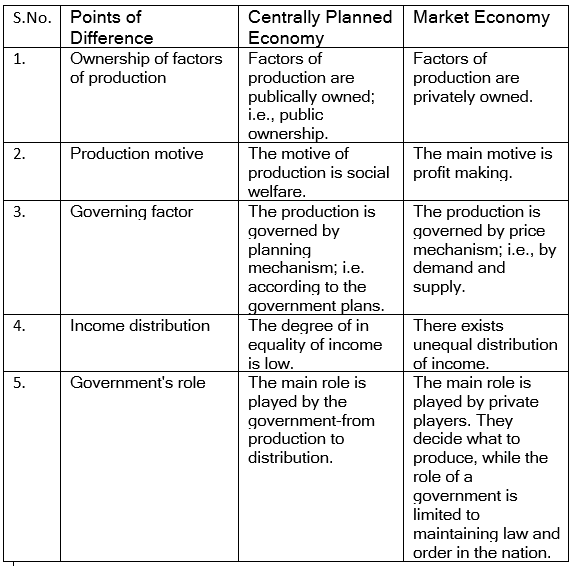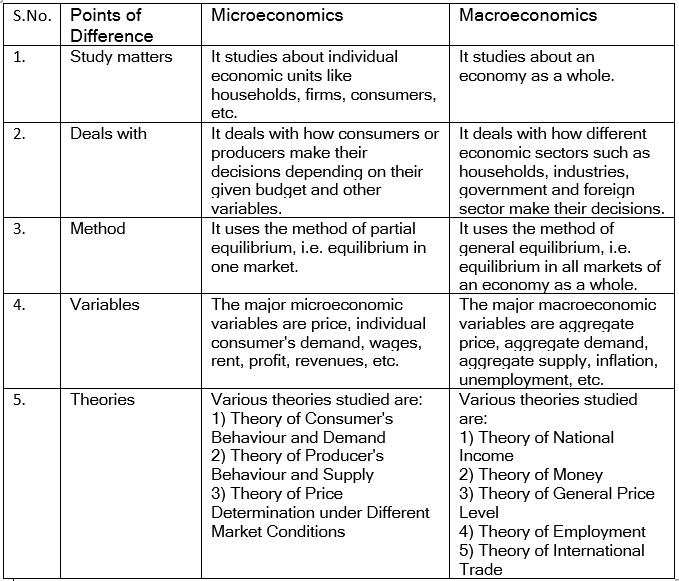NCERT Solutions for Class 11 Economics - Introduction to Micro Economics
Q1: Discuss the central problems of an economy.
Ans: Every economy faces three central problems due to the scarce availability of resources. This scarcity challenges the best possible usage of these available resources to fulfil unlimited demands. The three central problems of an economy are as follows:

(i) What to produce and in what quantities?
- The very first problem encountered by any economy is to decide what goods are to be produced and in what quantities or amounts.
- Every society faces a scarcity of resources. Because we live in a finite world, our resources have to be allocated based on our collective ‘needs and wants’ as a society. This creates a problem of choice, where we might have to choose between the different products that can be produced with the same available resources.
- There is a lot to be decided: whether to produce consumer goods or luxury goods, agricultural goods or investment goods, whether to cater to the education and healthcare sector or to strengthen the country’s military.
- Once it is decided what to produce, the next decision is to estimate the amount or quantity of the production. So, the economy constantly struggles to choose what to produce and in what quantities.
(ii) How to produce?
- The second problem that arises is how to harvest the given or available resources. That is, what technique is to be used for producing various goods and services?
- It depends majorly on the nation’s endowment of resources in deciding the optimum technique. It has to be decided whether efficient production is possible through labour-intensive or capital-intensive techniques.
- This decision rests on the present economic conditions and also on the fact that the selected technique shall not only reduce the cost of production but also add to the social and economic welfare.
- For example, if a country is facing wide unemployment, possibly due to a huge population, then it is wise to opt for labour-intensive techniques so that there is a reduction in unemployment.
(iii) For whom to produce?
- Finally, the purposeful distribution of final goods and services produced (national income) has to be done; that is, who gets what and how much?
- The economy needs to decide the best suitable mechanism for the distribution of the final products among different segments of society.
- The objective behind selecting such a mechanism is to reduce inequality of income, reduce poverty, and add to people's social welfare and standard of living.

Q2: What do you mean by the production possibilities of an economy?
Ans: Production possibilities of an economy imply those numerous alternative combinations of goods and services that a particular economy can produce with the given technology and employing the available resources fully and efficiently. In other words, it refers to various feasible bundles of goods and services that can be produced together by efficiently utilizing the given technology and available resources.
Q3: What is a production possibility frontier?
Ans: The production possibility frontier (PPF) refers to a curve that shows various alternative combinations of two goods that can be produced with efficient utilization of the given resources and technology. It is also called the production possibility curve (PPC).
 PPCAll the points lying on the PPC that is, curve AE, are associated with different quantities of good 1 and good 2 produced by employing the available resources fully and in an efficient manner. Meanwhile, any point lying under the curve, like F, depicts inefficiency or underutilization of available resources. Meanwhile, any point lying outside the curve, like Z, depicts overutilization of the available endowment of resources and technology, making it non-feasible.
PPCAll the points lying on the PPC that is, curve AE, are associated with different quantities of good 1 and good 2 produced by employing the available resources fully and in an efficient manner. Meanwhile, any point lying under the curve, like F, depicts inefficiency or underutilization of available resources. Meanwhile, any point lying outside the curve, like Z, depicts overutilization of the available endowment of resources and technology, making it non-feasible.
Q4: Discuss the subject matter of economics.
Ans: The subject matter of economics is subdivided into two core branches, microeconomics and macroeconomics. This division came into existence only after 1930, as per the suggestion by Ragnar Frisch. The domains of interest of these two branches of economics can be presented as follows:

(i) Microeconomics
- It is the study of individual economic units, i.e. the behaviour of consumers and firms. The study of how they utilize the given resources in the best possible manner in order to maximize their rational objectives falls under the domain of microeconomics.
- It is also the study of demand and supply and how their interaction determines the prices of various goods and services.
- Microeconomics helps in solving the three central problems of an economy. It is also called the Price theory, as it primarily focuses on how prices are determined both in commodity and factor markets.
(ii) Macroeconomics
- It is the study of how the economy as a whole operates. It focuses on the determination of aggregate measures, like aggregate demand, aggregate supply, and overall price level, and how they change over time.
- It is also known as the Theory of Income and Employment, as its main focus is on how income and employment levels are determined.
- Macroeconomics helps in understanding and solving problems like inflation, unemployment, Balance of Payments (BOP), disequilibrium, poverty, etc.
Q5: Distinguish between a centrally planned economy and a market economy.
Ans:

Ans:
- Positive economic analysis refers to the analysis in which we study what an economic problem is or how it is solved by analyzing various positive statements and mechanisms.
- These are factual statements and describe what was, what is, and what would be.
- These statements can be tested, proven, or disproven and do not involve personal value judgments.
- For example, if someone says that it is raining outside, then the truth of this statement can be verified. It deals with actual or realistic situations.

Q7: What do you understand by normative economic analysis?
Ans: Normative economic analysis refers to the analysis in which we study whether a particular mechanism is desirable or not.
- In this analysis, we study what ought to be the desired situation or in what ways the economic problems should be solved.
- In other words, it is concerned with what should be and what should not be and what is desirable and what is not.
- In normative economic analysis, we come across normative statements that cannot be tested as they involve personal value judgments. It deals with idealistic situations and is based on ethics.
- An example of a normative statement could be, ‘Central government should not stop providing minimum support price to the farmers’.

Ans:

|
58 videos|215 docs|44 tests
|
FAQs on NCERT Solutions for Class 11 Economics - Introduction to Micro Economics
| 1. What is microeconomics? |  |
| 2. What are the basic principles of microeconomics? |  |
| 3. How does microeconomics differ from macroeconomics? |  |
| 4. What are the main goals of microeconomics? |  |
| 5. How does microeconomics impact everyday life? |  |

|
Explore Courses for Commerce exam
|

|


















